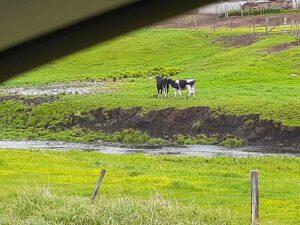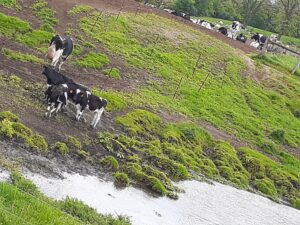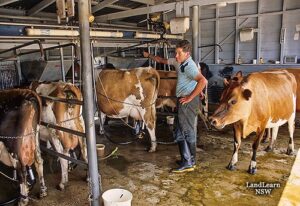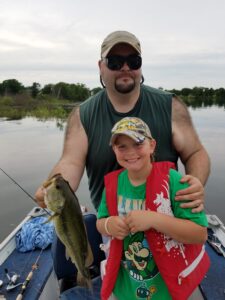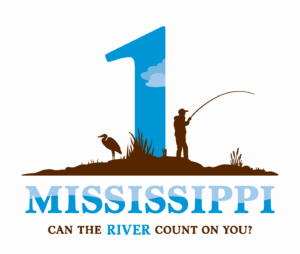Improvement is in Reach
Recognizing the Problem
It all starts with a quick fishing trip taken with my godson Josh and nephew Aaron, the latter you may remember from one of my previous blogs. Essentially, on a hot summer day, I decided to give the boys, whose care was my responsibility for that day, an experience similar to some remember very fondly from my own childhood. We would go dig up some worms from Grandma’s garden, then walk with our fishing poles to the stream running through my friend Dan’s family farm. It is just down the road less than a mile away. This small stream was a favorite spot for me during my childhood as my Grandmother commonly watched me when I was not in school because both my parents had daytime jobs. Typically, with a few worms and my pole I could burn an afternoon very quickly; catching Shiners, Chubs, and occasionally, if I was lucky, a Smallmouth Bass. The Smallmouth was then and remains my favorite fish to catch because of its violent strike and powerful acrobatic fight when hooked. All three of us were excited as we quickly walked to the stream after gathering our gear and digging up the worms.
I had just gotten the boys set up with their fishing rods and instructions not to be throwing rocks into the stream because it will scare the fish away. When I was pleasantly surprised by a booming, jovial voice loud enough to be heard over the babbling of the stream, interrupted my own preparations. “Hey there Old Boy! You get lost or something?” I turned with a wide grin to meet our unexpected visitor, my old friend from high school and owner of the property upon which we were fishing, Dan. He spotted us walking down the road to the stream as he was finishing the preparations needed to feed and milk his cows’ that evening. Knowing he had some time, as the cattle wandered into their stalls he grabbed a couple of beers and walked over to surprise us. 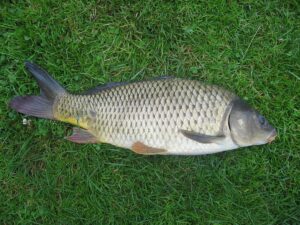
As I was occupied with the process of introducing my somewhat nervous and intimidated fishing buddies to the large and boisterous Dan; Josh’s fishing rod fell off of the forked stick where it had recently been set. Then, it quickly slid down and off the steeply eroded dirt bank into the stream. I was stunned as Dan quickly shoved his newly opened beer in my direction, took five quick steps, and then jumped into the calf-deep stream! Quickly grabbing the rod where it had gotten hung up on some old flood carried sticks. After Dan returned the pole to Josh, with fish still miraculously attached, we were treated to an exciting spectacle. Josh’s titanic battle and triumphant catch of a four-pound carp. After some smiles and congratulations, I was again surprised by Dan when he told me not to throw it back because he said there are way too many Carp in the stream and his hogs just love to eat them.
“Too many Carp?” I exclaimed in surprise. In the 35 years I have occasionally fished this stream I had only seen carp twice. Both of those times were in early spring when the stream was at or above flood stage. “Yeah, Carp, tiny Shiners, and the occasional Bullhead are all that seem to be in here anymore” was Dan’s response to my question. This was tangible proof of what I had seen slowly happening over the course of the past years. I had in fact, not been there in five years because all of the old deep places in the stream had filled in with silt and no longer held those Smallmouth Bass I so dearly enjoyed catching. The fact that the cattle were pastured directly in and around the stream was exponentially accelerating the streambank erosion. Even as a child I remember being cautioned not to fish off of the undercut areas where the bank was steeply eroded because they might break away and drop me into the stream.
Envisioning the Solution
Being a Conservation Biologist I decided to see if I could convince Dan to address this problem. Now, even with Dan in a jovial mood, I knew that convincing him to change the way his family had used their property since time immemorial would be nearly impossible. Having known Dan and his family for my entire life, I was acutely aware that my “hippie” big city views would do nothing but turn off his interest, eliminating my chance for successfully getting him to shift his practices. So for the time being I carefully avoided mentioning the fact that buffering his stream banks and wetland area would have a significant positive impact on downstream flooding, nutrient pollution, and the Dead Zone.
Dan, like myself, is an avid outdoorsman. His love of hunting and fishing gave me a much better avenue for convincing him that keeping his cattle off the stream banks, wetland area, and out of the stream except for small sections to cross and drink could be of great value to him. The potential improvement to the fishing, deer, turkey, waterfowl nesting and migration habitat was more than enough to make him at least listen to my thinking.The next and perhaps biggest stumbling block for my mission was the amount of money and time it would cost Dan to make the improvements. Now there are a number of great state and even federal programs that provide funds for landowners to create stream bank buffer zones, as well as even creating and restoring wetland areas. Unfortunately, the time required for the procedural red tape, knowledge of the existence of such funds, and trust in our governmental institutions to distribute them very often render them inaccessible to the average landowner. Dan, without help from those with such knowledge and skills, would never even consider looking into such avenues. Thankfully in this particular instance, the funds needed to create the buffer area and close off the small wetland would be pretty minimal. All said and done, a little over 3500 feet of electric fence wire, the corresponding wire insulators, posts, and charger was everything needed for the project. Certainly not free but not expensive enough to eliminate the project without other funding sources. I figured my offer to help him install it along with some Italian sausage I had made from the antelope I took the previous fall might just convince him.
The Proposal
All this was running through my mind as we finished our beers while watching the boys catch a few little Shiners. By chance, Dan’s wife was visiting her family out of state. Having the place to himself, he asked us to join him for dinner as he was going to grill some burgers after he milked his cattle. The fish were not really biting. So I figured the evening could give me a great opportunity to broach my project idea with him and give the boys a chance to see something that was totally new to them. Both boys were born and lived in suburban areas, dairy cattle being milked was sure to interest and educate them.
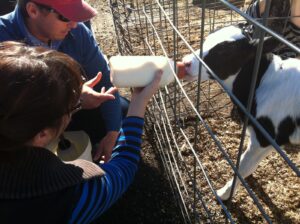
As typically happens, the exchange of hunting and fishing stories commenced as dinner began to wind to a close. This, just as I had hoped, provided me the opportunity to broach the stream bank buffer zone project I had been envisioning. His love for outdoor sports had him interested, but there were some initial doubts and resistance. He was concerned first about the expense. When I explained how it would just be the cost of electric fencing and the minimal effort to install it along with my offer of help, this resistance crumbled quickly. The final hurdle was the fact that he would be losing some acreage in which to pasture his cattle, and he didn’t want to do more harm than good by overgrazing the area.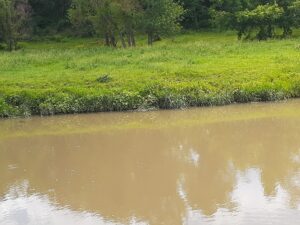
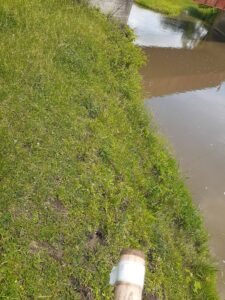
The Results
Did our project save the planet? Of course not, but it did prevent tons of sediment and micronutrients from being washed downstream to the Mississippi contributing to the Dead Zone. It is now a rare evening that Sandhill Cranes and Canada Geese cannot be heard calling with joy from their nesting areas in the area we protected. I even stopped there last summer to inspect our handiwork and see if it was still functioning as planned. I also happened to bring my fishing gear along and was pleasantly surprised to catch several immature Smallmouth Bass!
I share this with you not to brag, it is a good example of the fact that we can have a positive impact if we know-how. All of our situations are different so our routes to having a positive impact are as well. The 1 Mississippi program allows me as an Outreach Coordinator to give you knowledge of and access to such avenues. For further questions, reach out to info@1mississippi.org.
-Chris Stangl
1 Mississippi WI/IA Outreach Coordinator
Can The River Count On You?
Join our
COMMUNITY
And Get a Free E-book!
When you sign up as a River Citizen you’ll receive our newsletters and updates, which offer events, activities, and actions you can take to help protect the Mississippi River.
You’ll also get our free e-book, Scenes From Our Mighty Mississippi, an inspiring collection of images featuring the River.
Step 1
Become a River Citizen
Yes! The River can count on me!
I am committed to protecting the Mississippi River. Please keep me informed about actions I can take to protect the Mississippi River as a River Citizen, and send me my free e-book!, Scenes From Our Mighty Mississippi!
Step 2
LEARN ABOUT THE RIVER
We protect what we know and love. As a River Citizen, you’ll receive our email newsletter and updates, which offer countless ways to engage with and learn more about the River. You can also follow us on Instagram, Facebook, X (Twitter) , and YouTube, where we share about urgent issues facing the River, such as nutrient pollution, the importance of floodplains and wetlands, and bedrock legislation such as Farm Bill Conservation Programs.
Step 3
Take Action
There are many ways you can jump in and take action for a healthy Mississippi River. Our 10 actions list includes simple steps you can take at any time and wherever you are. Check out our action center for current action alerts, bigger projects we are working on, and ways to get involved.

